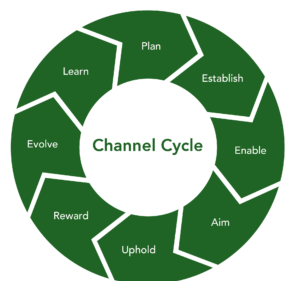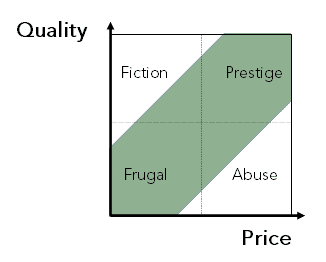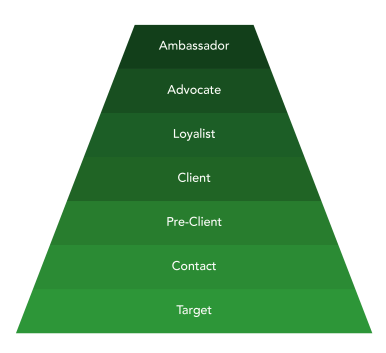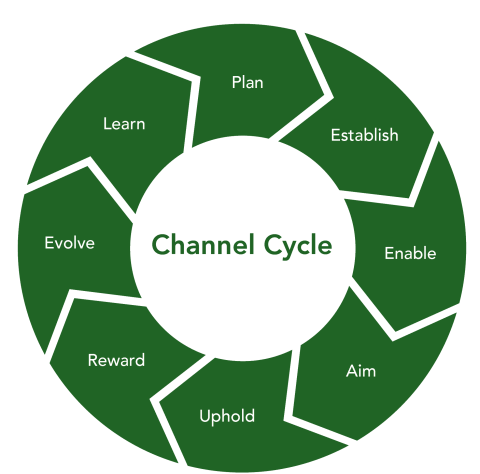The channel cycle, a new approach to boost the growth of your intermediated business


Imagine that your intermediaries consider you the first choice for their clients. Would that boost growth in your company?
Being the first choice of intermediaries is not impossible, but you need the right tools.
One of them is the channel cycle.
A few stories
Some time ago, I was in a meeting with the CEO of one of my company's intermediaries – an insurance broker – to discuss how we could collaborate to grow the intermediary's business (and consequently my company's). The broker said that our offer was not competitive enough. Then I asked him a few questions:
- Is your business growing? He said no, it hadn't grown for many years and competition was increasing, especially from multinationals.
- Are the commissions that other insurers pay you above or below ours? He said they were equivalent to my company's commissions (the broker was one of our intermediaries with lower commissions).
- What kind of offer do you prefer, the best quality or the lowest price? He said both, he always offered his clients the best quality offer and the lowest price.
- So, to propose our offer to your clients, do we have to be the least profitable on the market? He didn't respond, but said his focus was on maximizing value for the client.
Recently, when I was doing a consultancy job for a wine producer, I noticed that the company's profitability had declined in 2020 and 2021. At that time I asked the CEO some questions:
- What explains the behavior of your sales in 2020 and 2021? He said that in 2020 the business volume dropped 37% because of the covid hysteria, having reduced 54% in the on-trade channel (horeca and distributors) and 76% in the duty-free channel, it wasn’t worse only because the off-trade channel (food retail) grew by 10%. In 2021, they recovered and managed to slightly exceed the turnover of 2019, thanks to a huge increase in the off-trade channel and distributors in the on-trade channel.
- Is profitability lower in these channels? He replied “yes, because the product range has lower margins in the off-trade channel and I had to significantly increase the commercial team in the on-trade channel to have a greater number of distributors”.
- And in the on-trade channel, are all distributors interesting? The answer was that they all sell...
At another company, an importer of very prestigious and custom-installed kitchen and sanitary equipment, I asked the CEO what the company's most important channels were. He said they only had one personalized sales channel. Then I asked:
- Where are your sales opportunities coming from? The answer was that leads are always generated by a salesperson.
- Do your salespeople often have contacts with architects, construction project managers and real estate developers? He replied yes, in some cases the company even paid them commissions.
- Do they register that data in an information system? He answered “yes and no”, they registered the opportunities, but only indicating which ones had commissions associated to them.
- And do you know what opportunities a particular architect, or one of the other types of intermediaries, is involved in? He replied that they didn't have it registered, but the salespeople knew.
These stories demonstrate the incomplete view, on the part of both producers and intermediaries, of the partnership between them. Intermediaries are (intermediate) clients of producers (even if they do not buy and only intermediate sales, as in the case of insurance brokers and architects), but they only have a relationship with producers to sell to their clients, that is, they are inevitably business partners.
In the first case, the positioning of the insurance broker revealed a commodity mindset. The broker considered itself the champion of its clients, neglecting the interests of the insurance companies that are its business partners. Even after many decades in the market, it could not grow because it insisted on having the “fiction” positioning illustrated in the diagram below:

It’s common sense that there is a high correlation between quality and price, within the “frugal-prestige” strip. The “fiction” positioning reveals a focus on the short term, it isn’t credible or, even if it occurs occasionally (for example when a company wants to gain market share quickly without being profitable), it isn’t sustainable. The “abuse” positioning also reveals a focus on the short term and carries a huge reputational and sustainability risk in the market. The broker needed a change of approach in the relationship with its partners in the value chain, both insurers and clients, to be able to grow sustainably. My company needed to continue to monitor the broker's behavior to decide whether to demote him to the weak intermediary category or to upgrade its category.
In the second case, the wine producer reacted to the harmful effects the government caused on society due to covid, having recovered in 2021 after losing money in 2020. However, it privileged sales without taking profitability into account. The wine producer needed to adapt the size of its sales team to the business potential of its distributors, using what is known as the “double Pareto” approach, which consists of concentrating the dedication of commercial managers’ time on median intermediaries with greater potential:
DEDICATION | TYPE OF INTERMEDIARY | BEHAVIOR |
|---|---|---|
20% | TOP | Strengthen trust, in the few moments of contact |
60% | MEDIAN | Uphold intensively, contacting frequently |
20% | WEAK | Support reactively, without spending too much time |
In the third case, the company didn’t recognize the intermediaries in the sale as its intermediate clients, it needed to develop its marketing pyramid and categorize some intermediaries as strategic clients.

The channel cycle
Being the first choice of intermediaries is difficult, you can’t improvise. The only way is to have a systematic approach to manage the relationship with intermediaries. It doesn't matter if your sales channel is B2B2C or B2B2B, you must perform all the necessary activities to excel. Hence the channel cycle.

The channel cycle represents the annual cycle of managing the relationship with intermediaries, from planning up to earning from its execution and its outcome.
The channel cycle has eight macro-activities:
ACTIVITY | DESCRIPTION |
|---|---|
PLAN | In this activity, you need to create the conditions for the success of the channel:
|
ESTABLISH | This activity consists of establishing distribution contracts with intermediaries, taking the channel's territorial plan (expansion, reduction or maintenance of intermediaries) into account. Establishing distribution contracts is a mix of selling (which must be carried out according to the sales cycle) and recruiting a team of salespeople (it is not advisable to use the mirror test, which consists of recruiting everyone who can fog it up with the breath). |
ENABLE | The better trained the intermediaries are, the better the sales. Not only because they have more competence, but also because they have more confidence in the producer company. You must understand that intermediaries lend their reputation to the producer and want to keep their clients for the long term, so they only sell what they are comfortable selling. It is up to commercial managers to execute the annual enablement plan, in which the applicable conditions for the implementation of training, support and the provision of equipment were defined. |
AIM | Metrics and objectives for each intermediary category are defined in the channel plan. In this activity, intermediate goals are established for each intermediary, to be monitored throughout the year, to be able to achieve annual goals that can be higher, equal to or lower than those of the category, depending on the potential of the intermediary. |
UPHOLD | Upholding intermediaries is the most time-consuming activity for commercial managers and should be managed according to the “double Pareto” approach (see above). It involves, not exhaustively:
|
REWARD | When the intermediary belongs to the supply chain (for example a retailer), the main component of its remuneration is the channel margin, which is the difference between the selling price to the client (downstream) and the purchase price from the producer (upstream). When the intermediary does not belong to the supply chain, but only to the sales chain (for example an insurance broker), the main component of its remuneration is the sales commission. Both channel margins and sales commissions must be attractive enough for the intermediary to sell the producer's offer. In addition, Producers can also include other components in the remuneration of intermediaries, for example incentives and/or sponsorships, which in turn can be monetary or in kind. The sky is no longer the limit when it comes to imagination about the kind of incentives and sponsorships that can be given to intermediaries (it is now possible to offer trips to space). |
EVOLVE | The objective of this activity is to update the category of intermediaries, considering the possibility of evolution and the need for demotion. It’s in the mutual interest of the producer and the intermediary to have the most advanced category possible, because it represents better conditions for developing the business, but it is essential to periodically update the category of each intermediary because it influences the time allocation of commercial managers, which is critical to the success of the partnership. |
LEARN | To learn means to gain knowledge, understanding and skills by analyzing and reflecting upon the accumulated experience. Learning is a team endeavor, it requires constant monitoring, discussion and analysis of successes and failures and sharing of insights with intermediaries. |
In the most sophisticated producer companies, the channel cycle is supported by PRM (partner relationship management) systems, which are integrated with CRM (customer relationship management), production and financial systems. Curiously, most producer companies manage the activities of the channel cycle in a disjointed way and without systems integration:
- Territorial planning isn’t performed because “the more intermediaries, the better”.
- Establishing distribution contracts is done uncritically, neglecting the good practices of the sales cycle.
- The enablement of intermediaries is the responsibility of the training department, without connection with sales objectives and without considering the specific situation of each intermediary.
- Setting objectives for intermediaries is neglected.
- Upholding intermediaries is done in the same way by commercial managers, regardless of the performance and potential of each intermediary, requiring excessive dedication from commercial managers both to top intermediaries (whom do not need their support) and weak intermediaries (whom do not contribute much to the business).
- The remuneration of intermediaries does not include incentives and sponsorships to boost sales and strengthen sales capability.
- Intermediaries are all in the same category, regardless of their placement in the marketing pyramid.
- Learning is not considered a business process.
Being the first choice of intermediaries
Properly executing the channel cycle activities allows you (in theory) to be the first choice of your intermediaries, however (in practice) this is impossible without your commercial managers earning their trust and continuously developing it.
To earn and develop trust from intermediaries, in addition to carrying out the activities of the channel cycle, your commercial managers must meet three requirements:
- To have a thorough knowledge of your company's offer and the rules of relationship with intermediaries.
- To have a thorough knowledge of the competition and the market.
- To demonstrate that they have a genuine interest in intermediaries.
The first two requirements are relatively simple, although they demand a constant effort to keep knowledge up to date. The third requirement is more complex and, in addition to carrying out the activities of the channel cycle, it requires maintaining a close professional relationship:
- Honor commitments.
- Remember the intermediary's business and individual context in each contact.
- Communicate with empathy.
- Show enthusiasm.
- Be proactive, anticipating risks and opportunities.
Your company has several benefits when using the channel cycle to manage the relationship with your intermediaries:
- Choosing the right intermediaries (some are not worth working with).
- Maximize sales by intermediaries due to the systematization in managing the relationship and the constant alignment of interests.
- Optimize the time dedicated by your commercial managers to intermediaries with the greatest growth potential.
- Learning as a team to constantly improve in each activity.
The combined effect of these benefits is to boost the growth of your intermediaries' business and, consequently, your company’s. Your sales channel starts to function like a machine, with all its components perfectly aligned.
In addition, the channel cycle has a visual advantage. The relationship with your intermediaries is no longer a sales process with a beginning and an end, but an endless cycle of continuous improvement favored by the learning activity.
Conclusion
The channel cycle is an innovative concept, based on many years of research of the best practices around the world in all types of intermediated businesses. By implementing it, your company uses an important tool to gain competitive advantage over your competitors.
Now you know how to be the first choice of your intermediaries, driving their growth and your company’s.
Filipe Simões de Almeida
Managing Partner, Fi Consulting
Posted on 4-May-2022
